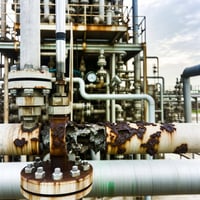In the Oil & Gas industry, the maintenance and preservation of equipment are crucial for ensuring...
Long-Term Storage in the Oil & Gas Industry
A few years ago, a refinery encountered significant issues with control valves that had been stored long-term without adequate humidity protection. Rust and corrosion compromised the valves' functionality, requiring expensive and extensive maintenance to restore proper operation.





Long-term storage of equipment in the Oil & Gas industry is a complex challenge that requires detailed planning and the implementation of stringent protective measures. The harsh environment, characterized by high humidity, salinity, and extreme temperatures, can severely compromise mechanical equipment and threaten its integrity.
In this short article we will explore best practices for long-term storage to avoid incidents where the failure to adopt such practices has led to significant damage.
Corrosion Protection-
- Use of Protective Coatings: Apply anti-corrosion coatings on exposed surfaces to prevent oxidation.
- Use of Corrosion Inhibitors: Employ chemical compounds that prevent rust and corrosion inside critical components.
-
- Dehumidification Systems: Install dehumidifiers within storage areas to maintain controlled humidity levels.
- Desiccant Packages: Use silica gel packs or other desiccants inside sealed containers to absorb residual moisture.
-
- Preventive Maintenance Programs: Conduct periodic inspections and preventive maintenance to identify and address potential issues before they become critical.
- Continuous Monitoring: Implement sensors for continuous monitoring of environmental conditions and equipment status.
-
- Hermetic Containers: Use sealed, weatherproof containers to protect equipment from external elements.
- Moisture Barriers: Employ moisture barriers such as barrier films or vapor-proof bags to protect internal components.
Is it possible to have proper packaging and continuous monitoring?
Until now, the requirement to use specific materials with a high degree of protection from atmospheric agents, such as barrier films, to seal high-value equipment components has precluded the possibility of continuous monitoring.
This means that if the barrier film is faulty at the time of packaging, or if it is accidentally opened during storage or shipment, resulting in inadequate protection, the component can corrode without anyone noticing. Only when it arrives at its destination, when it is too late, will the problem be detected.
In addition, the smart devices on the market (with RFID, QRcode, Bluetooth technologies) do not solve this problem because they are designed to be installed either on the component itself or externally on the box.
In the first case, the aluminium barrier bag shields any type of signal and the data collected by these devices can only be acquired after the packaging has been opened.
In the second case, these devices detect external conditions but do not provide any useful information about the state of health of the component inside the barrier bag.
HALOG is the solution that allows you not to sacrifice continuous monitoring for better protection, and vice versa. HALOG can be installed directly on the aluminium bag and allows you to monitor the humidity level and set an alarm at a specific threshold to be notified before the corrosion process starts, saving money and reducing the company's liability.
Proactive management prevent costly repairs and ensure operational continuity of facilities.




